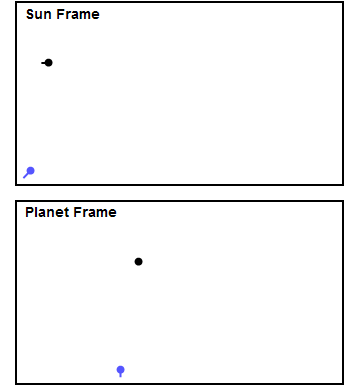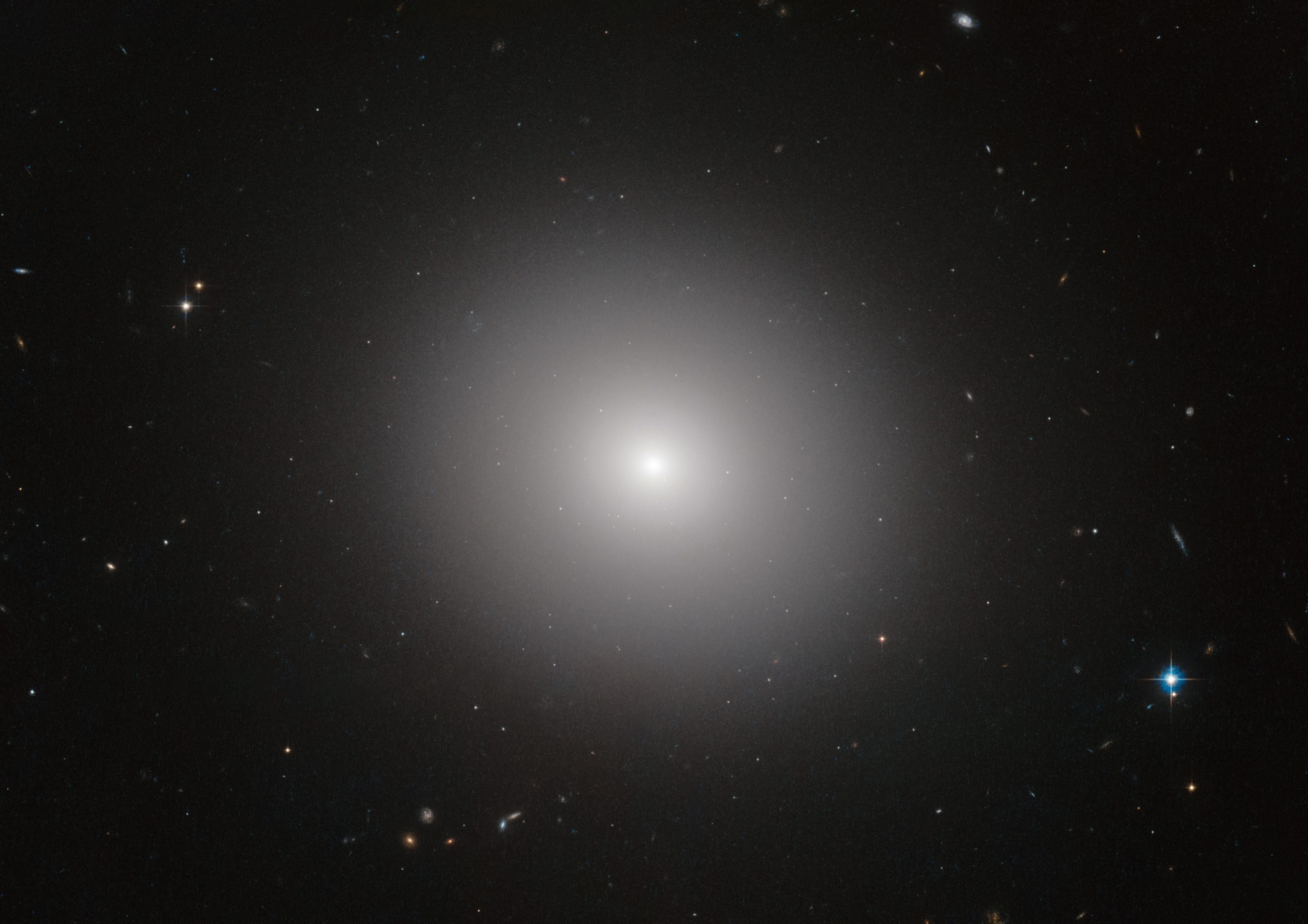|
Mass Deficit
In astronomy, mass deficit is the amount of mass (in stars) that has been removed from the Galactic bulge, center of a galaxy, presumably by the action of a binary star, binary, supermassive black hole. The density of stars increases toward the center in most galaxies. In small galaxies, this increase continues into the very center. In large galaxies, there is usually a "core", a region near the center where the density is constant or slowly rising. The size of the core – the "core radius" – can be a few hundred parsecs in large elliptical galaxy, elliptical galaxies. The greatest observed stellar cores reach 3.2 to 5.7 kiloparsecs in radius. It is believed that cores are produced by binary supermassive black holes (SMBHs). Binary SMBHs form during the galaxy merger, merger of two galaxies. If a star passes near the massive binary, it will be ejected, by a process called the gravitational slingshot. This ejection continues until most of the stars near the center of th ... [...More Info...] [...Related Items...] OR: [Wikipedia] [Google] [Baidu] |
Astronomy
Astronomy is a natural science that studies celestial objects and the phenomena that occur in the cosmos. It uses mathematics, physics, and chemistry in order to explain their origin and their overall evolution. Objects of interest include planets, natural satellite, moons, stars, nebulae, galaxy, galaxies, meteoroids, asteroids, and comets. Relevant phenomena include supernova explosions, gamma ray bursts, quasars, blazars, pulsars, and cosmic microwave background radiation. More generally, astronomy studies everything that originates beyond atmosphere of Earth, Earth's atmosphere. Cosmology is a branch of astronomy that studies the universe as a whole. Astronomy is one of the oldest natural sciences. The early civilizations in recorded history made methodical observations of the night sky. These include the Egyptian astronomy, Egyptians, Babylonian astronomy, Babylonians, Greek astronomy, Greeks, Indian astronomy, Indians, Chinese astronomy, Chinese, Maya civilization, M ... [...More Info...] [...Related Items...] OR: [Wikipedia] [Google] [Baidu] |
Galaxy Merger
Galaxy mergers can occur when two (or more) Galaxy, galaxies collide. They are the most violent type of Interacting galaxy, galaxy interaction. The Gravitation, gravitational interactions between galaxies and the friction between the gas and Cosmic dust, dust have major effects on the galaxies involved, but the exact effects of such mergers depend on a wide variety of parameters such as collision angles, speeds, and relative size/composition, and are currently an extremely active area of research. Galaxy mergers are important because the merger rate is a fundamental measurement of Galaxy formation and evolution, galaxy evolution and also provides astronomers with clues about how galaxies grew into their current forms over long stretches of time. Description During the merger, stars and dark matter in each galaxy become affected by the approaching galaxy. Toward the late stages of the merger, the Potential energy, gravitational potential begins changing so quickly that star orbits ... [...More Info...] [...Related Items...] OR: [Wikipedia] [Google] [Baidu] |
David Merritt
David Roy Merritt (born November 16, 1955, in Los Angeles) is an American astrophysicist. He is known for Osipkov–Merritt model, the Leonard–Merritt mass estimator and the M–sigma relation. Education and career He received in 1982 his PhD in Astrophysical Sciences from Princeton University with thesis advisor Jeremiah P. Ostriker and held postdoctoral positions at the University of California, Berkeley and the Canadian Institute for Theoretical Astrophysics in Toronto. Merritt's fields of specialization include dynamics and evolution of galaxies, supermassive black holes, and computational astrophysics. Until 2017, he was a professor at the Rochester Institute of Technology (RIT) in Rochester, New York. He was a former Chair of the Division on Dynamical Astronomy of the American Astronomical Society. He is a founding member of the Center for Computational Relativity and Gravitation at RIT. His scientific contributions include Osipkov–Merritt models, bl ... [...More Info...] [...Related Items...] OR: [Wikipedia] [Google] [Baidu] |
Sphere Of Influence (black Hole)
The sphere of influence is a region around a supermassive black hole in which the gravitational potential of the black hole dominates the gravitational potential of the host galaxy. The radius of the sphere of influence is called the "(gravitational) influence radius". There are two definitions in common use for the radius of the sphere of influence. The first is given by r_h = \frac where ''M''BH is the mass of the black hole, ''σ'' is the stellar velocity dispersion of the host bulge, and ''G'' is the gravitational constant. The second definition is the radius at which the enclosed mass in stars equals twice ''M''BH, i.e. M_\star(r [...More Info...] [...Related Items...] OR: [Wikipedia] [Google] [Baidu] |
Princeton University Press
Princeton University Press is an independent publisher with close connections to Princeton University. Its mission is to disseminate scholarship within academia and society at large. The press was founded by Whitney Darrow, with the financial support of Charles Scribner, as a printing press to serve the Princeton community in 1905. Its distinctive building was constructed in 1911 on William Street in Princeton. Its first book was a new 1912 edition of John Witherspoon's ''Lectures on Moral Philosophy.'' History Princeton University Press was founded in 1905 by a recent Princeton graduate, Whitney Darrow, with financial support from another Princetonian, Charles Scribner II. Darrow and Scribner purchased the equipment and assumed the operations of two already existing local publishers, that of the ''Princeton Alumni Weekly'' and the Princeton Press. The new press printed both local newspapers, university documents, '' The Daily Princetonian'', and later added book publishing ... [...More Info...] [...Related Items...] OR: [Wikipedia] [Google] [Baidu] |
Monthly Notices Of The Royal Astronomical Society
''Monthly Notices of the Royal Astronomical Society'' (MNRAS) is a peer-reviewed scientific journal in astronomy, astrophysics and related fields. It publishes original research in two formats: papers (of any length) and letters (limited to five pages). MNRAS publishes more articles per year than any other astronomy journal. The learned society journal has been in continuous existence since 1827 and became online only in 2020. It operates as a partnership between the Royal Astronomical Society (RAS), who select and peer-review the contents, and Oxford University Press (OUP), who publish and market the journal. Despite its name, MNRAS is no longer monthly, nor does it carry the notices of the RAS. In 2024 MNRAS became a purely gold open access journal. History The first issue of MNRAS was published on 9 February 1827 as ''Monthly Notices of the Astronomical Society of London'' and it has been in continuous publication ever since. It took its current name from the second vo ... [...More Info...] [...Related Items...] OR: [Wikipedia] [Google] [Baidu] |
Gravitational Slingshot
A gravity assist, gravity assist maneuver, swing-by, or generally a gravitational slingshot in orbital mechanics, is a type of spaceflight flyby which makes use of the relative movement (e.g. orbit around the Sun) and gravity of a planet or other astronomical object to alter the path and speed of a spacecraft, typically to save propellant and reduce expense. Gravity assistance can be used to accelerate a spacecraft, that is, to increase or decrease its speed or redirect its path. The "assist" is provided by the motion of the gravitating body as it pulls on the spacecraft. Any gain or loss of kinetic energy and linear momentum by a passing spacecraft is correspondingly lost or gained by the gravitational body, in accordance with Newton's Third Law. The gravity assist maneuver was first used in 1959 when the Soviet probe Luna 3 photographed the far side of Earth's Moon, and it was used by interplanetary probes from Mariner 10 onward, including the two Voyager probes' no ... [...More Info...] [...Related Items...] OR: [Wikipedia] [Google] [Baidu] |
The Astrophysical Journal
''The Astrophysical Journal'' (''ApJ'') is a peer-reviewed scientific journal of astrophysics and astronomy, established in 1895 by American astronomers George Ellery Hale and James Edward Keeler. The journal discontinued its print edition and became an electronic-only journal in 2015. Since 1953, ''The Astrophysical Journal Supplement Series'' (''ApJS'') has been published in conjunction with ''The Astrophysical Journal'', with generally longer articles to supplement the material in the journal. It publishes six volumes per year, with two 280-page issues per volume. ''The Astrophysical Journal Letters'' (''ApJL''), established in 1967 by Subrahmanyan Chandrasekhar as Part 2 of ''The Astrophysical Journal'', is now a separate journal focusing on the rapid publication of high-impact astronomical research. The three journals were published by the University of Chicago Press for the American Astronomical Society until, in January 2009, publication was transferred to IOP Publis ... [...More Info...] [...Related Items...] OR: [Wikipedia] [Google] [Baidu] |
Galactic Bulge
In astronomy, a galactic bulge (or simply bulge) is a tightly packed group of stars within a larger star formation. The term almost exclusively refers to the group of stars found near the center of most spiral galaxies (see ''galactic spheroid''). Bulges were historically thought to be elliptical galaxies that happened to have a disk of stars around them, but high-resolution images using the Hubble Space Telescope have revealed that many bulges lie at the heart of a spiral galaxy. It is now thought that there are at least two types of bulges: bulges that are like ellipticals and bulges that are like spiral galaxies. Classical bulges Bulges that have properties similar to those of elliptical galaxies are often called "classical bulges" due to their similarity to the historic view of bulges. These bulges are composed primarily of stars that are older, Population II stars, and hence have a reddish hue (see stellar evolution). These stars are also in orbits that are essentiall ... [...More Info...] [...Related Items...] OR: [Wikipedia] [Google] [Baidu] |
Cambridge University Press
Cambridge University Press was the university press of the University of Cambridge. Granted a letters patent by King Henry VIII in 1534, it was the oldest university press in the world. Cambridge University Press merged with Cambridge Assessment to form Cambridge University Press and Assessment under Queen Elizabeth II's approval in August 2021. With a global sales presence, publishing hubs, and offices in more than 40 countries, it published over 50,000 titles by authors from over 100 countries. Its publications include more than 420 academic journals, monographs, reference works, school and university textbooks, and English language teaching and learning publications. It also published Bibles, runs a bookshop in Cambridge, sells through Amazon, and has a conference venues business in Cambridge at the Pitt Building and the Sir Geoffrey Cass Sports and Social Centre. It also served as the King's Printer. Cambridge University Press, as part of the University of Cambridge, was a ... [...More Info...] [...Related Items...] OR: [Wikipedia] [Google] [Baidu] |
Elliptical Galaxy
An elliptical galaxy is a type of galaxy with an approximately ellipsoidal shape and a smooth, nearly featureless image. They are one of the three main galaxy morphological classification, classes of galaxy described by Edwin Hubble in his Hubble sequence#Physical significance, Hubble sequence and 1936 work ''The Realm of the Nebulae'', with their intermediate scale disks, a subset of the "early-type" galaxy population. Most elliptical galaxies are composed of older, stellar evolution#Low-mass stars, low-mass stars, with a sparse interstellar medium, and they tend to be surrounded by large numbers of globular clusters. Star formation activity in elliptical galaxies is typically minimal; they may, however, undergo brief periods of star formation when merging with other galaxies. Elliptical galaxies are believed to make up approximately 10–15% of galaxies in the Virgo Supercluster, and they are not the dominant type of galaxy in the universe overall. They are preferentially fou ... [...More Info...] [...Related Items...] OR: [Wikipedia] [Google] [Baidu] |





